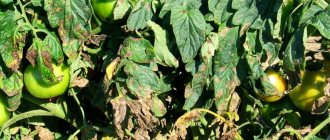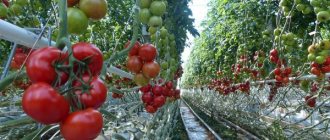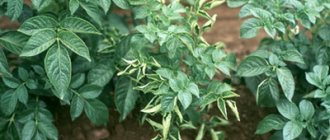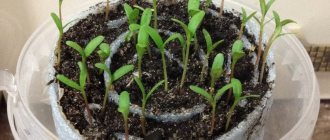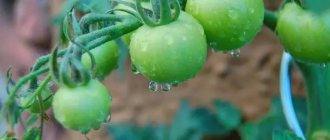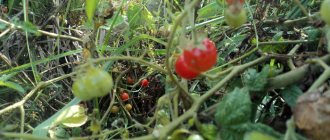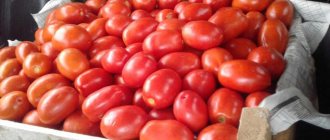Everyone wants to quickly enjoy the taste of tomatoes grown with their own hands.
But sometimes it happens that the fruits ripen very slowly. This is especially true for late varieties that ripen closer to autumn. Dear readers!
For you, we have created communities on social networks in which useful articles and interesting ideas are published several times a day! Subscribe and receive useful content in a convenient format! Today we decided to talk about the reasons for the long ripening of tomatoes and ways to speed up the reddening of the fruit.
Why tomatoes don't ripen
Before we look at ways to speed up the ripening of tomatoes, let’s look at the reasons for their delayed redness.
Firstly, this is an incorrectly selected variety. Late-ripening tomato varieties have a longer growing season and take longer to ripen than early and mid-ripening varieties.
Therefore, it is very important to choose the right variety for your climate zone.
Secondly, the reason for the long ripening of fruits may be a cold and short summer.
Tomatoes are a heat-loving crop. For normal development and fruiting, the plant needs a warm summer with plenty of sun and pleasant temperatures.
If this is not the case, then the fruits will take a long time to fill. In addition, their taste will suffer.
Ripening time
Of course, in closed ground, plants form fruits faster, and their ripening period is much shorter than when growing tomatoes outdoors. How long it takes from germination to fruiting depends on the variety or hybrid. Growing hybrid plants is considered the most profitable from an economic point of view in conditions of short and cool summers.
Hybrid seeds are designated by the manufacturer on the packaging as F1. Experienced vegetable growers already have their own preferences in varieties and hybrids. It is not easy for summer residents who are beginning to grow tomatoes to understand the huge assortment of seeds, and in the pursuit of a large harvest, mistakes are sometimes made that affect the number of formed and ripened fruits.
There are several unpretentious varieties and hybrids that novice vegetable growers are especially successful in growing. Such tomatoes are not only advantageous for their early ripening, but also form a friendly and large harvest of high-quality marketable fruits. These varieties and hybrids include tomato seeds “Typhoon”, “Semko”, “Verilioka” and “Druzhok”. To obtain a very early harvest and minimize the time spent on ripening, it is recommended to plant the varieties “Uragan”, “Samara”, “Yantarny” and “Junior”.
It is very important to remember that the earliest ripening is typical for varieties belonging to the determinate type. However, the indeterminate type of tomatoes produces a more abundant harvest. If it is necessary to grow an unpretentious, abundantly fruiting and early-ripening plant, preference should be given to modern zoned hybrids. Knowing how long the growing season takes, it is quite easy to determine the timing of planting such tomatoes.
How to speed up the ripening of tomatoes in open ground
Next, let's look at some proven methods that will help tomatoes turn red faster.
Removing stepchildren
This procedure helps to thin out tomato plantings and provide the fruits with the necessary level of light for ripening.
Breakage of leaves on the lower tiers
Old leaves take up too much nutrition and energy. As a result, practically nothing reaches the fruits located on the upper tiers. Gradually pick off the leaves under the fruits, and they will begin to ripen faster.
Pinching the top of the head
In the last ten days of July and early August, you can pinch to stop the growth of the tomato.
As a result, nutrients will begin to spread throughout the plant, including the fruits.
Pick brown tomatoes
If the tomatoes begin to turn red, pick them every 3-4 days. If you wait until they are completely ripe on the branch, you will have to wait even longer for the next fruits.
Treatment with compounds that accelerate ripening
You can speed up the process of reddening of tomatoes by spraying with special compounds. Let's look at some of the most popular ones:
- Iodine water. You need 30 drops per bucket of water. Apply in the morning or evening after the heat of the day has subsided.
- Magnesium sulfate. You need 2 teaspoons of the drug per bucket of water.
- Superphosphate. Fertilizer is prepared in several stages. First, 2 tablespoons of the drug are dissolved in 2 liters of water and left to infuse for a day. Then the volume of working fluid is increased to 10 liters and the tomatoes are sprayed.
- Potassium humate. The working solution is prepared according to the instructions. Treatment can be carried out every ten days.
Watering with special compounds
In addition to spraying, tomatoes can be watered to speed up ripening. Let's look at some compositions.
- Pink solution of potassium permanganate. Used for irrigation when spraying is not possible.
- Ash infusion. Pour a glass of ash into a bucket and leave for 2 hours. Afterwards, water the tomatoes and feed them with ash infusion at the rate of 1 liter per 1 bush.
Covering tomatoes
Tips and reviews from gardeners on accelerating the growth of tomatoes
Experienced gardeners also use other methods to speed up the ripening of tomatoes, which they happily share.
Tips from gardeners to speed up the growth of tomatoes:
- you can use ordinary plastic bags - they are put on brown tomatoes, tied tightly at the base, but a small hole is made in the middle part for ventilation;
- water with an infusion of nettles and dandelions - put 1/3 of the herbs in equal proportions in a 10-liter container, pour boiling water to the very top, leave for 2-3 days, and before use, dilute with water in a ratio of 1:10;
- Collect the tomatoes without tearing off the stems, place them in the room in one layer, leave the light on for at least 12 hours;
- if there was a late blight infection, be sure to leave the tomatoes in another place - separately from healthy fruits, otherwise blackening will occur.
Before you start accelerating the ripening of tomatoes, carefully study all the methods and subtleties of this process. But it is best to adhere to preventive measures in advance - do not perform prohibited actions. Follow the agrotechnical requirements for a particular variety, and the tomatoes will turn red in time.
0
0
Copy link
How to speed up the ripening of tomatoes in a greenhouse
In principle, everything that has been said for tomatoes growing in a garden is also true for bushes growing in a greenhouse.
But still, we will describe in more detail everything you need to know about stimulating ripening in a greenhouse.
- Be sure to carry out pinching and pinching the top of the head. These procedures will help redistribute nutrients and direct their flow to the redness of the tomatoes.
- Maintain the temperature around 25 degrees. This is the optimal temperature for the tomatoes to plump and ripen. Temperatures below 20 and above 35 stop the life processes inside the tomato.
- Provide the required level of illumination for plantings. The fruits of this crop need sun to turn red. If there is not enough of it, the fruits will turn red for a very long time.
- Using a smoke bomb. During the combustion process, carbon dioxide will be released, which tomatoes need to accelerate ripening.
Why do tomatoes not turn red for a long time on the bush?
The life cycle of a tomato is simple: in the first 30 days the vegetable grows and increases in size, and in the next 20-25 days it becomes plump and turns red. The most delicious and healthy tomato is the one that turns red in the garden. This is why it is so important to pick ripe tomatoes.
By the way, the scarlet color is not always appetizing - it is necessarily a sign of maturity. If you bought a miracle of foreign selection, a hybrid variety, then even a red tomato may be unsweetened and tasteless. What's the matter? When breeding a hybrid, breeders have to, among other things, influence the color gene. When the vegetable turns red, it is still in a state of technical ripeness. Therefore, when harvesting, be guided by the recommended harvest time.
green tomatoes
But let's return to the usual tomatoes. Common reasons for late ripening of tomatoes are as follows:
- You have selected mid-late, late-ripening or tomato varieties that are not suitable for your region. The most recommended for the Russian climate are ultra-early and early-ripening.
- The temperature in the greenhouse is either too low or too high. Suitable indicators for tomatoes are 22-29° C. If the temperature regime is disrupted, lycopene processes inside the fruit are disrupted.
- Excessive exposure to sunlight. The harvest burns out before it has time to turn red.
- Unsuitable microclimate. High humidity and sudden temperature changes also negatively affect ripening.
- Planting too thick. The distance between bushes should not be less than 30 cm.
- You used special means that stimulate the rapid and abundant development of the ovaries. But preparations such as “Ovary” or “Bud” contain gibberellic acids, which delay subsequent ripening.
- Incorrect fertilization scheme. If you overdo it with nitrogen, the leaves will take on a grayish-golden color, and the reddening of the crop will slow down. A slowdown in ripening is also observed with potassium deficiency - it is combined with “woodiness” of the shoots.
Proper watering during tomato ripening
During the ripening period, watering tomato beds can be reduced. The specific moisture regime depends on the varietal characteristics.
So, low-growing specimens can be stopped watering altogether in 3-4 weeks. But for tall tomatoes, watering needs to be reduced. You need to carry out the procedure twice a week (or even less often), but pour a little more water than usual.
Signs of maturity
Any vegetable grower knows that tomatoes need to be collected or picked at the stage of incomplete ripeness. A properly harvested crop in a greenhouse guarantees the production of high-quality tomatoes, which can be used not only for ripening, but also for full processing. Tomatoes must be harvested while respecting the ripening time, and the first tomatoes in the greenhouse are picked at the stage of full ripeness.
The main signs of ripeness that allow for timely harvesting depend on the variety of tomato and the method of growing it. The timing of determining when it is possible to harvest fully ripe tomatoes in a greenhouse varies greatly. The climatic conditions of Russia require the planting of early ripening varieties, which can be harvested as early as possible.
We also recommend that you read the article in which we talk about the best varieties of tomatoes for greenhouses.
What not to do when the tomatoes are ripe
Now let’s look at what not to do when tomato fruits turn red.
- Eliminate nitrogen from the plant diet. This microelement is needed for the growth of green mass, but not for the ripening of fruits. In addition, nitrogen worsens the taste of tomatoes.
- Reduce watering. Tomatoes now have absolutely no use for excess moisture. The procedure may cause the fruit to burst.
- Eliminate organic fertilizers.
Features of care
If all the tomatoes in the greenhouse do not turn red, the fault is due to improper care. In rare cases, the problem lies in the shortcomings of the variety itself.
Growing in a greenhouse has its own nuances. High humidity does not have a very good effect on the formation of fruits, although they like the soil to be abundantly moist. Therefore, make sure that the level does not exceed the norm.
No artificial lighting can replace a plant’s natural light source. Still, try to ensure the maximum that special lamps for greenhouses can provide.
You can force tomatoes to ripen at the same time by following the following rules:
- watering the soil: frequent, but dosed;
- soil fertilization: alternation of organic matter and minerals, nutrition based on phosphorus, nitrogen and potassium fertilizers;
- weeding and timely removal of weeds will facilitate the widespread growth and development of the nightshade crop;
- pinching and gartering: removing unnecessary shoots and forming stems is a condition for obtaining a neat bed;
- spraying: late blight, viral tobacco mosaic and gray rot are the main enemies of tomatoes.
Traditional methods for accelerating the ripening of tomatoes
Summer residents have come up with quite a few unusual ways to speed up the ripening of tomatoes. Let's look at some of them.
Stimulation with ripe fruits
The essence of the method is that ripe fruits of other berries and fruits are hung on tomato beds. They release ethylene into the atmosphere, which accelerates the ripening of fruits.
Piercing
Disinfect a toothpick with alcohol and pierce the fruit in several places around the stem. The puncture does not need to be larger than 10 mm.
It has been noted that pierced tomatoes ripen faster.
ON A NOTE. Please note that such tomatoes will not have a marketable appearance. The method is applicable only to fruits that will be processed or eaten.
Through cut
At a level of 15-20 cm from the ground, a sharp knife is used to make a through puncture in the main shoot of the bush. Then a “spacer” (wooden stick) is inserted inside. This mobilizes all the forces of the plant to bear fruit.
REFERENCE. If you insert a piece of copper wire into such a puncture, this will protect the bush from late blight and other fungal diseases.
Vodka “vaccinations”
You can speed up fruit ripening with vodka injections. You only need 0.5 ml for each fruit. Alcohol stimulates ripening.
Damage to small roots
Quite an unusual way. You need to grab the stem and pull the plant out of the ground until it cracks. This means that small roots have been damaged. Now the energy will be redirected to the fruits.
IMPORTANT! This method is very controversial. We do not recommend using it unless you have sufficient experience growing tomatoes.
Turning towards the sun
Remove any leaves that protect the tomatoes from the sun. Rotate the brushes and fix them so that they are always illuminated.
Caring for bushes for early ripening
“Lazy” bushes are provided with special care:
- Don’t forget about proper fertilizer: alternate mineral and organic fertilizers. Nutrition should be comprehensive - nitrogen, potassium, phosphorus + microelements.
- It is important to pay due attention to weeding: overgrown weeds shade cultivated plants and take away water and nutrients from them.
- When planting medium- and tall-growing plants, do not forget about the sequential formation of the bush - garters and pinching.
- If the plants are low-growing, carefully turn their lower branches towards the sun, securing them securely with slingshots and spacers.
- Another measure for low- and medium-sized plants: leave 4-5 fruit-bearing branches and remove all the rest.
- If you have tall greenhouse tomatoes, leave up to 10-12 fruit-bearing branches in a heated greenhouse, and no more than 6-7 brushes in an unheated greenhouse. Perform pinching around mid-August in order to have time to collect fully ripe tomatoes from the middle branches and partially ripened tomatoes from the top ones before frost.
- Remember, cold dew begins to fall in the first weeks of August. Close greenhouses at night to prevent plants from getting blight.
- Carry out preventive spraying against diseases fatal to tomatoes - late blight, gray rot and tobacco mosaic.
If the tomato still “does not want” to devote all its energy to ripening the tomatoes, then the last resort is to artificially create extreme conditions for it, in which the plant will be forced to “choose” fruits as a priority. To do this, the bushes are sprayed with simple chemical solutions:
- Iodine. For 10 liters of water - 15 ml (30-40 drops) of an alcoholic medical solution of iodine. This volume is enough to process 1.5 m2 of greenhouse beds.
- Sulfate. For 1 liter - 10 g of magnesium sulfate.
- Solyanoy. For 10 liters of water - 200 g of ordinary salt. Use the solution carefully, because salinization of greenhouse soil will not lead to good consequences.
Before moving on to stress spraying, keep in mind that after the procedure the plant will completely stop growing and will not form new fruiting clusters. Therefore, I advise using this measure no earlier than the last week of August or beginning of September.
ripe tomatoes
Reduce watering
The simplest thing you can do to speed up the ripening of tomatoes is to minimize watering. In the future, adhere to a simple schedule of water procedures: frequent but dosed watering.
I significantly reduce watering of greenhouse tomatoes about a month before harvest. If the summer is humid and not hot, water procedures can be canceled altogether. But this measure is not suitable for areas with deep groundwater. A useful “side” effect of reducing watering: tasty “sugar” tomatoes without unpleasant wateriness and acidity.
Elimination of nitrogen fertilizing
In many cases, the slowdown in the ripening of vegetables is due to the fact that they have gone too far with nitrogen fertilizers. After all, the main task of this element is to promote the growth of green mass in the first stages of plant development. Therefore, by the time of flowering and setting of the first fruits, organic and inorganic nitrogen fertilizers are gradually reduced to nothing.
Removing flower stalks, leaves, tops
A more drastic measure, which has helped me more than once, is pinching, trimming certain parts of the plant:
- Peduncles. In the last days of July and the beginning of August, I examine my tomatoes for flowers that have not yet begun to set. I remove these inflorescences, since they will no longer have time to form into full-fledged tomatoes, but they will be able to draw from the plant the forces necessary for the ripening of ready-made fruits.
- Leaves. I periodically remove excess tops, which darken the formed tomatoes. After all, bright sunlight is the key to ripening the crop. I do not spare the lower branches, which are usually located below the fruit clusters.
- Tops. Removing the crown in midsummer is a must for indeterminate tomatoes. If you do not stop the growth of plants artificially, they will continue to grow, “forgetting” about the ripening of the fruits. In the case of greenhouse plants, the growing point is removed as soon as the top reaches the ceiling of the greenhouse. No more than 2-3 leaves are left above the inflorescences with setting tomatoes, thereby ensuring the development of the fruits. When I need to harvest faster, I pinch off the top in the second half of July.
How to ripen green tomatoes
You can also pick green tomatoes and then ripen them at home.
Milky-wax specimens are suitable. Elastic and dry. That is, the fruits should already be almost ripe, just not reddened.
You need a box or wooden box where unripe fruits are placed in one layer. Then the box is placed in a dark place with high humidity.
The advantage of this method is that you can control the speed at which the tomatoes turn red. In warm conditions (25-30 degrees), the fruits will ripen quickly, in 3 days. In cool weather (+10) for a week and a half.
ON A NOTE. There is another way. Bushes are pulled out of the ground and hung upside down indoors.
Tomato sowing dates for different regions
Tomato seedlings are planted in the ground after the threat of return frosts has disappeared and the soil has warmed to 10-12°C. Of course, these times will differ in different regions. Let's take a closer look at the conditions and recommended dates for sowing and transplanting for areas with different climatic conditions.
Southern regions
In the mild climate of the southern regions, planting seedlings in open ground is possible already in early May, and in a greenhouse even earlier. This means that you can sow tomatoes even in February. Thus, it is recommended to sow seeds of late-ripening varieties from February 15 to March 5; for sowing mid- and early-ripening tomatoes, the end of February or the first ten days of March is suitable.
Central Black Earth Region
The climate here is favorable for early sowing of any crop, and tomatoes are no exception. Tomatoes of early-ripening varieties can be sown for seedlings from March 1 to 20, and mid-ripening and late varieties - from February 25 to March 15.
Middle lane
In the middle zone, tomato seeds are usually sown for seedlings from the end of February until almost the end of March. Late varieties of tomatoes are sown first, then mid-season ones, and lastly, early and ultra-early ones. Moreover, the earliest ripening varieties can be sown until the beginning of April - they will have time to grow and ripen during the season, even in open ground. It is recommended to plant seedlings in protected soil after May 15, and in open soil after June 5.
Ural and Siberia
In these regions, seedlings are planted in the ground closer to mid-June, which means there is no need to rush into sowing seeds. Tomatoes of mid-season and late varieties are usually sown from March 15 to 25, and for early tomatoes the appropriate sowing time is April 1-10.
Common mistakes
In an effort to speed up the ripening of tomatoes, gardeners often make mistakes. Let's sort them out.
- Excessive watering. This is the most common and most serious mistake. When a summer resident sees that the fruits do not want to turn red, he thinks that they do not have enough water. But excessive watering only leads to cracking of the fruit.
- No procedures are carried out at all. Left to their own devices, tomatoes will take a very long time to ripen.
- Growing unsuitable varieties. Not everywhere in Russia you can grow late-ripening varieties of tomatoes. In many regions, tomatoes simply do not have time to ripen.
- Organic feeding. Tomatoes do not need excess nutrients at the fruit ripening stage.
Removing leaves
The gradual removal of leaves to the cluster that is just beginning to ripen also promotes accelerated ripening of fruits. Since tomatoes ripen from the bottom to the top, gradual pruning of leaves should begin from the bottom.
However, if there is extreme heat, this procedure should be abandoned, especially on the south side of the row: in the heat, the leaves protect the fruits from sunburn. If the summer turns out to be cool, an operation such as removing leaves will significantly speed up the ripening of the crop.
Answers to frequently asked questions
Tomatoes don't turn red, what should I do?
Stimulate their maturation using any method available to you. You can pick green fruits and ripen them at home.
Is it possible to pick green fruits?
Yes. If they have acquired a milky-waxy tint. You can put them in a box and they will ripen there.
Do I need to pick off the leaves?
It is advisable, but there is no need to cut everything off. Just tear off everything below the first bunch of tomatoes.
Which tomato varieties take longer to ripen?
On average, tomatoes turn red within 65-80 days after planting. However, there are late varieties that are most often used for long-term storage. The duration of ripening of varieties is up to 130 days. These varieties include:
- Long Keeper;
- New Year;
- Long lasting;
- Giraffe;
- Lying;
- Winter heart.
Despite the fact that these varieties ripen later than others, summer residents often grow them on their plots.

